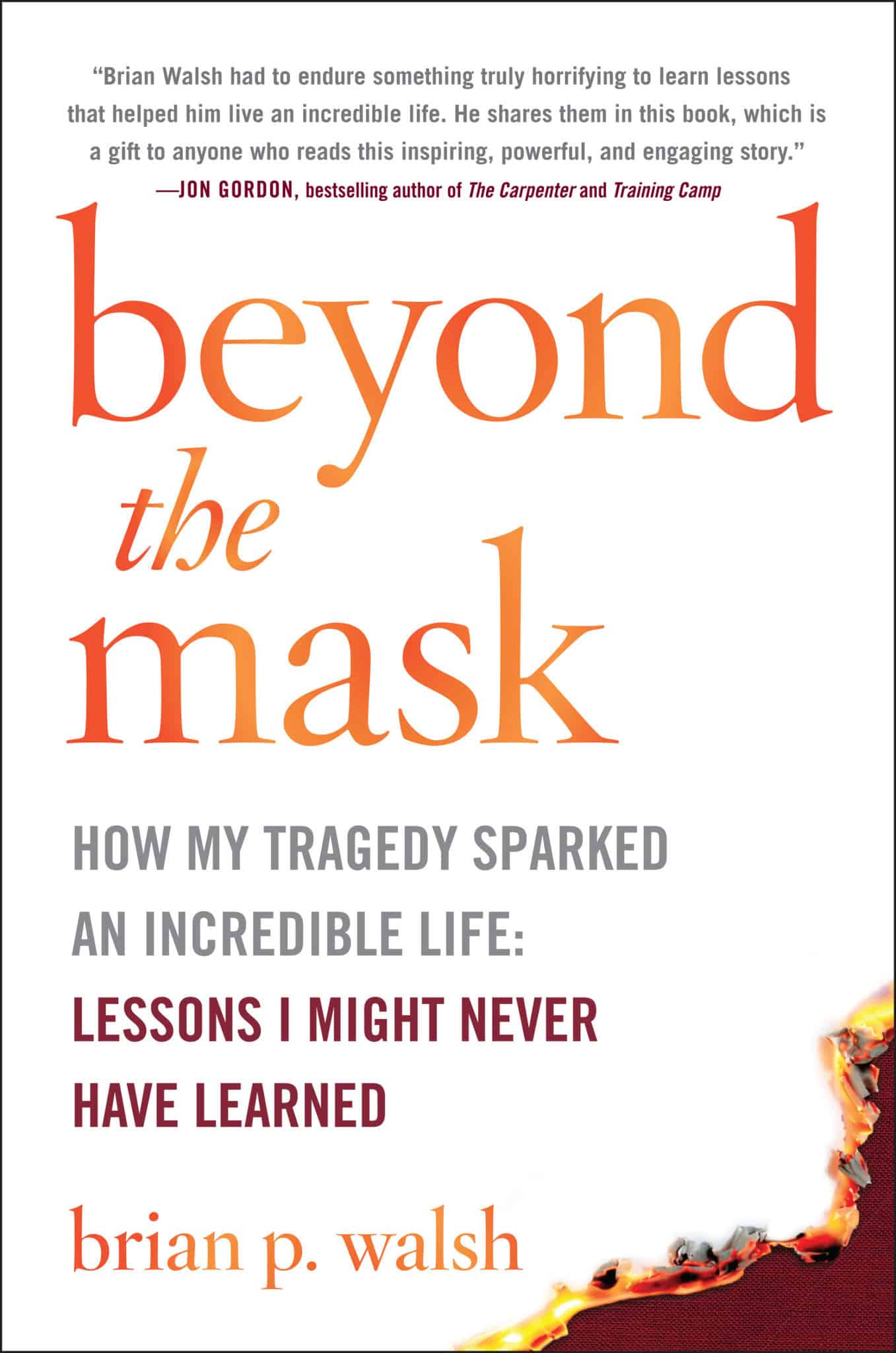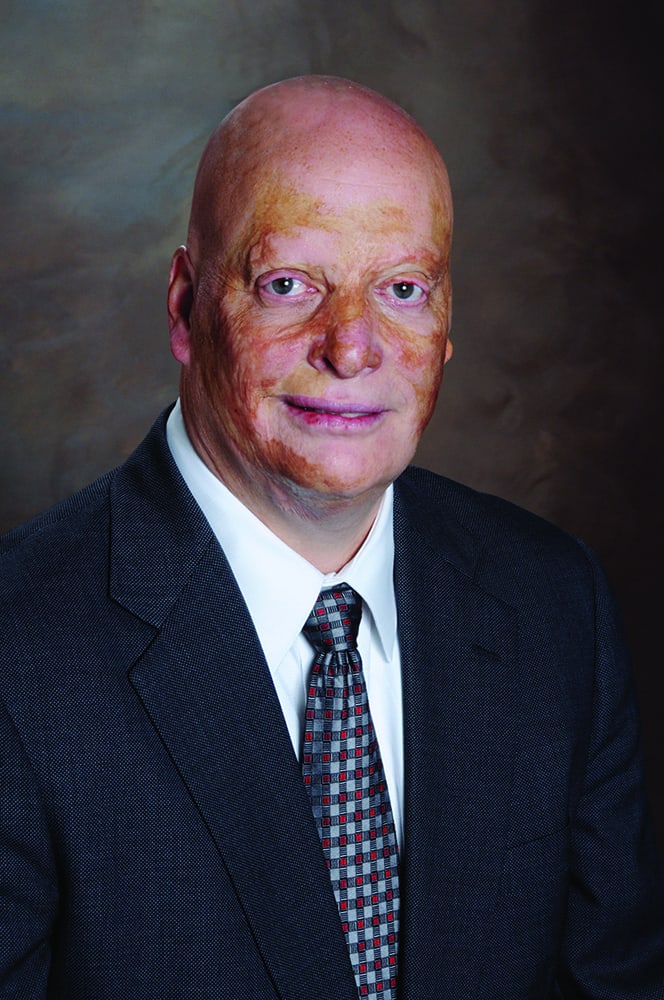Beyond the Mask
As a seventeen-year-old volunteer firefighter, Brian Walsh suffered third-degree burns to his face. But he chose not to let that tragedy destroy him, and instead used it to create a magnificent life—both personally and professionally.
Minutes before Brian Walsh, then just a teenager, heard his beeper go off, calling him to help put out another fire, he was on top of the world. An hour later, after a freak flashover and confusion that sent the junior firefighter into the inferno against regulations, Brian had suffered such profound burns to his face that he was unidentifiable to his fellow firefighters.
Nearly everyone expected him to die that night.
He did not.
Nearly everyone expected him to die in the burn unit where, over the next month, every other patient died.
Nearly everyone, including family and friends, expected Brian to choose a professional life that would keep him from showing his face, and the personal life of a hermit.
He did not.
Boldly forging a path forward with courage, grace, and determination, Brian silenced his doubters and defied all expectations.
Decades later, Brian is an extraordinarily successful and renowned financial planner, family man, community fixture, philanthropist, motivational speaker, and industry leader. In this stirring autobiography, he tells his incredible story, sharing the lessons that only tragedy could teach and how they helped him—and can help anyone—achieve greater success, inside and out.
Beyond the Mask is the moving and inspirational story of how one horrific moment can define a human being forever—in the most life-affirming way.
“Beyond the Mask puts everything in its place…perspective and a tremendous bolt of courage and inspiration.”
—Sir Philip Anthony Hopkins, Actor, Director and Film Producer
“Brian Walsh had to endure something truly horrifying to learn lessons that helped him live an incredible life. He shares them in this book, which is a gift to anyone who reads this inspiring, powerful, and engaging story.”
—Jon Gordon, bestselling author of The Carpenter and Training Camp
“Sometimes the best life lessons are learned from people who have gone through unimaginable hardship. Brian Walsh pushed through his tragedy to become one of the best leadership teachers, and his reflections and advice are invaluable.”
—Dana Perino, Former White House Press Secretary
“This book is filled with real life wisdom that can help you be more, do more, and serve more.”
—Nido Qubein, President of High Point University
“I’ve been telling Brian Walsh for years that he needed to write a book. He did not just write one, but he wrote a great one. My friend learned to live a life with a new face. And he now teaches us to do the same…to put down our masks, face ourselves and ignite a fire in our heart to live, lead, and love in a more burning way.”
— Tommy Spaulding, New York Times bestselling author of The Heart-Led Leader and It’s Not Just Who You Know
The upside of that, for me, was that I probably got a more accurate idea of what people thought of me than most people do for themselves. I once saw an interview where Terry Saban, wife of the legendary college football coach Nick Saban, said something like, “Nick’s biggest problem is he doesn’t know how other people view him.”
Seriously? Given Coach Saban’s reputation as controlling and a perfectionist, that seemed like a pretty damning thing for her to say about her husband. I wondered if the comment was scripted, some kind of goof. The more I thought about it, though, the more fascinating I found it. Could it be that one of the most detail-oriented, hyper-aware successes really didn’t know how he came off in public?
Of course it could! Because it’s true of most people, successful or not.
Because most people can’t tell for sure what others think of them.
Not me. I’ve had my problems the last thirty-plus years. That ain’t one of them.
Before I go further, I need to tell you about my mask.
A couple of weeks after I left the burn unit, I lay down on a cushioned platform in the office of my occupational therapist, Ruth, who gave me a straw to breathe through before she slathered plaster on my face, everywhere but the eyes, nostrils, and mouth. Within a couple of hours the plaster hardened into a shell, Ruth peeled it off my face, then sent the mold to a manufacturer, and within a week we got back a hard plastic mask, like a hockey goalie’s. I wore it, with a pressure garment made of stretchy but tight fabric over it to apply added pressure, to keep the scars from keloiding—thickening and hardening, like rope left too long in the sun. I would need to wear the mask as long as the scar tissue kept growing. Every two months, Ruth and I went through this process, making a new mold, so that the mask could apply maximum pressure to the parts of the face that needed it most.
I also had a mouth extender, a metal bar with plastic at each end that could be cranked to widen, if needed. I inserted the contraption into my mouth, then expanded it until my mouth was sufficiently stretched, for the purpose of working the skin and muscles in and around my mouth so that I could talk and eat normally. Here, too, I would return to the doctor every couple of months, so he could evaluate how well my skin was stretching, and we would usually expand the device a little more.
I wore the mask approximately twenty-three hours a day, taking it off only when I ate, showered, or lubricated my face. I wore the mouthpiece when I slept, like a retainer. I wore both for two years.
If you think walking around in public with a disfigured face is tough, you should see the reaction to someone dressed as Jason from Friday the 13th when it’s not Halloween.
I’m a pretty good judge of character. Is it because I literally wore a mask for so long that I felt like a walking camera, catching people letting their guard down when I was nearby because I didn’t appear to be a full, normal person? Is it that, with or without a mask, I could see in people’s eyes what they were thinking about me, and they couldn’t hide it? Is it a salesman’s trick, the ability to size people up in a few seconds? Is it being part of a big, complex family? Maybe all of it, maybe none.
How do people see you? Because if you can see accurately how people see you, then you should also be able to see yourself more accurately, or at least the part that others tend to focus on. How can you find that sweet spot, that valuable place where you see yourself neither as worse nor better than you are? Wearing a mask for two years gave me an advantage in all this. I might even call it, yes, a gift. People noticed me; they couldn’t not. People stared. People wondered what horror lay beneath. Once, waiting at the Philadelphia train station with my mother, a woman in her early twenties came up to me, stuck her face right up to mine, and studied me, like I was something in a museum or a zoo. “What are you doing?” my mother snapped at the woman, who didn’t have the decency to acknowledge that there was an actual human being behind the mask.
Some people looked at me with almost transcendent compassion.
The mask was extremely tight and could get physically uncomfortable. Add to that the shark liver oil rubbed on my face twice a day to keep the skin supple (though it was still so much more brittle than “real” skin feels like), and it took a while to get used to. The mask was also my companion and protector, my daily reminder, my truthteller. Yes, it was also hiding a truth. But the fact that I had it on, out in the world, said something truthful, too.
Wear an actual mask long enough and you get to thinking about the masks worn by others. Masks that are invisible, but not really. Masks that try to obscure a truth, but often reveal it at the same time.
I came to see that almost everyone wears a mask. For some it’s a mask of overconfidence, to hide their insecurity. For some it’s a mask of focus, to hide their fear of inertia or irrelevance or a general lack of purpose. For some it’s a mask split in two, allowing them to say one thing to some people and a completely contradictory thing to others: people who “talk out of both sides of their mouth.”
When I stopped wearing my literal mask, it wasn’t easy. It was impossible to lie about my face. But whatever it looked like and whatever it said about me, mistakenly or not, I fought through it. I was done with masks. I wanted to be who I was, whoever and whatever that might be.
I imagine it’s equally hard, maybe even harder, to stop wearing a mask you’ve been wearing a long time that’s not physical. Maybe you didn’t even realize you were wearing one, or that you wear it in certain situations. But it can settle and harden.
I try my best not to bullshit anyone. I know from my family and closest friends that I’ve succeeded at that maybe too much because, frankly, I’m not to everyone’s taste. I can be hard for some people to take. That’s a downside of being an extreme non-bullshitter. (Jim Noonan was right: I can be a pain in the neck.) The upside is living what feels like a more honest life, one where you’re a lot closer to who you are, what you want, and who you want to spend time with.


